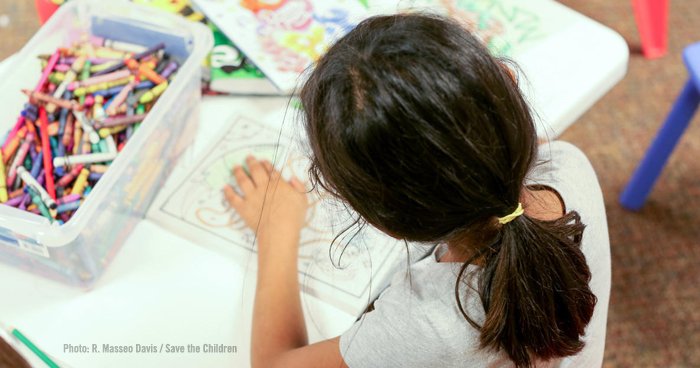
A child draws at one of the respite centers in New Mexico.
Save the Children is proud of its 100-year history meeting the specific needs of kids. When disaster strikes, Save the Children is there with the resources meant for our littlest and most vulnerable neighbors. So, when I was first trained on how to be a Save the Children Emergency Responder when disaster strikes here in the United States, I was ready to respond to the next natural disaster. Little did I know that instead, I’d be at the U.S./Mexico border providing much needed respite to families newly released from detention.
During emergencies, the unique needs of children are often overlooked. Supplies like diapers, formula, cribs, and even toys aren’t always seen as high-priority necessities. We know kids process and feel things in different ways, which makes it even harder to return to a sense of normalcy after an emergency. That’s where Save the Children’s “Child Friendly Spaces” (CFS) and community play spaces come in.
CFS’s are designated spaces that provide children with a safe environment where they can participate in activities to play, socialize, learn and express themselves. It’s a place where children can simply be kids, despite the trauma or stress they’ve endured. Let me answer some common questions!
Where are the Save the Children CFS located?
Save the Children has partnered with city-operated hospitality shelters in New Mexico to set up designated CFS. Decorations and children’s artwork line the walls, children can play in rooms designed for a variety of activities, and parents can rest and make plans in larger shelter areas not too far from their kids while trained adults play and watch over their kids.
What happens at a CFS?
Every day, my team would brainstorm different activities to engage the kids in the shelters. Hot potato, or “papa caliente” in Spanish, tended to be a favorite, especially when played to the soundtrack of Frozen, also in Spanish. We colored, drew pictures of our families and made pipe cleaner butterflies and skydivers. We bounced around a giant ball, seeing how high we could count in Spanish or Portuguese. I was even “diagnosed” a number of times by curious kids who discovered our pretend doctor kit. The fake stethoscopes helped us find a common language with the Brazilian kids, who I sometimes struggled to communicate with because I don’t speak Portuguese. Turns out, corazón, or heart, is the same in Spanish and Portuguese and just so happens to be in the same place on everyone, regardless of where they’re from or what language they speak.
Strangely, I found joy in being the punchline of many jokes. While I’m proud of my Spanish, I’d be a fool to say I know how to “play” in Spanish. The kids would regularly laugh at my car sounds or silly questions about their drawings.
“No, Jessica, no es una mariposa, es una mariposita” – “No Jessica, that’s not a butterfly, it’s a little butterfly.” Whoops!
What do CFS mean for parents?
CFS’s are an incredible resource for parents, because in disaster, they ALSO have specific needs. Parents are welcome to accompany their children and play in the CFS. There’s a designated area, called a Parent and Baby Area, for them to diaper change, nurse and hold their babies while rocking in chairs.
My team and I encouraged parents to come color with their kids, especially since adult coloring is a great stress reliever. Parents would sit down at our little tables and pick out their favorite color crayons with their kids and create masterpieces.
More than anything, a CFS is a breath of fresh air for parents because they know that their child is safe and returning to a sense of normality through play and laughter.
Learn how you can help families at the border.
Editor’s Note: This blog is the second blog of a 4-part series around Save the Children’s work at the border. See below to learn and read more about Save the Children’s work at the border.
– I just spent 3 weeks working with children at the U.S. border. This is what’s really happening there.
– Stuffed Sharks Bringing Joy at the Border
- Do Small Things with Great Love